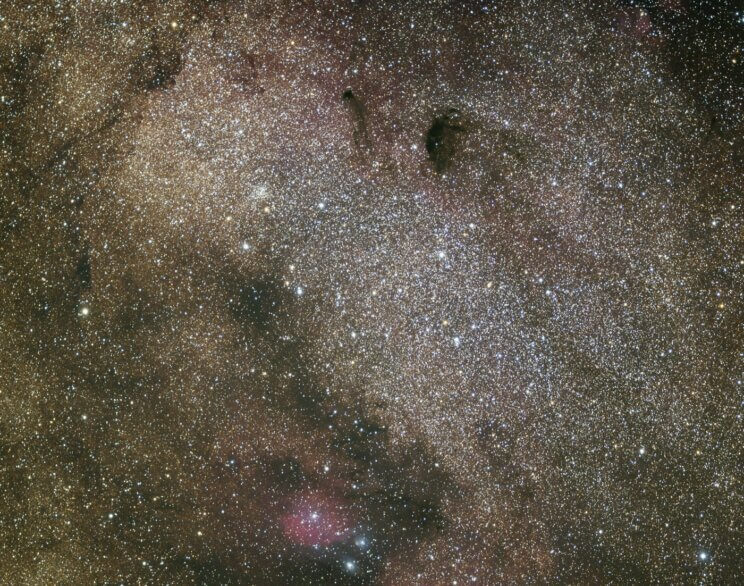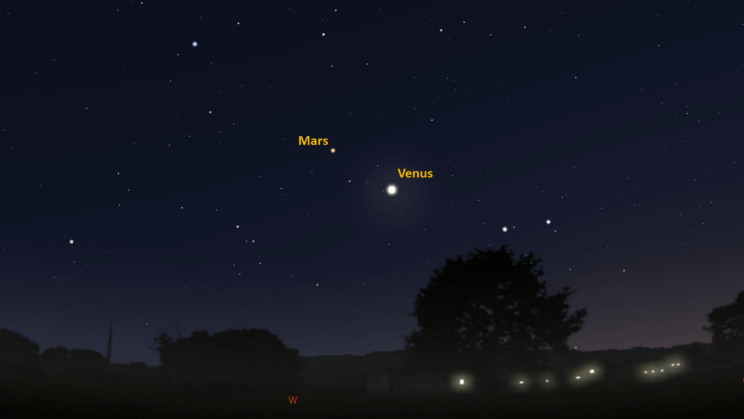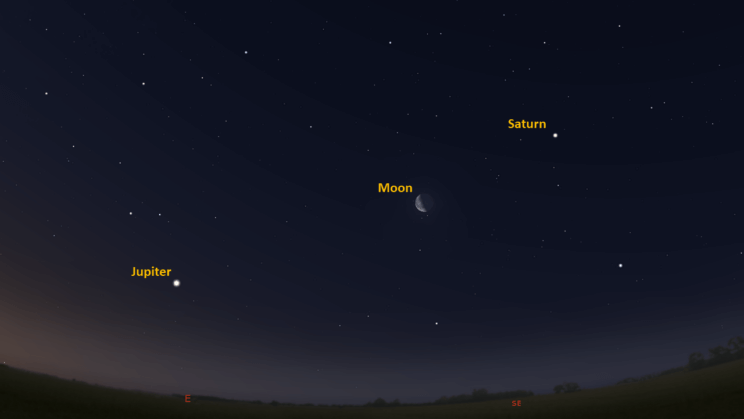This is the Saint Louis Science Center’s NIGHT SKY UPDATE for the week of Friday, June 9, 2023.
Information updated weekly or as needed.
Times given as local St. Louis time which is Central Daylight Time (CDT). For definitions of terminology used in the night sky update, click the highlighted text. If relying on times posted in Universal Time (UT), St. louis is -5 hours when CDT.
Public Telescope Viewings
As part of the Saint Louis Science Center’s First Fridays, weather permitting, the St. Louis Astronomical Society and the Science Center will set up a number of telescopes outdoors and be on-hand to answer your questions. Telescope viewing begins once it is dark. Regardless of the weather on August 4 , join us indoors in our planetarium theater for “The Sky Tonight”. Showtime is at 7 p.m. There is no First Friday event in July.
Observing Highlight of the Week

The Little Sagittarius Star Cloud also know as Messier 24 is a dust free window into the neighboring Carina-Sagittarius arm of the Milky Way. Image credit: Thomas Jäger.
The highlight for this week is a unique deep sky object called Messier 24 (M24). Found in Sagittarius, M24 is one of the few objects in the messier catalog that is not a star cluster, nebula or galaxy. M24 is called a star cloud as it offers a view of roughly 1000 stars. When observing this object, you are looking through a relatively dust-free corridor into the Sagittarius arm of the Milky Way galaxy.
M24 is also called the Little Sagittarius Star Cloud. As the name implies, M24 is found in the constellation Sagittarius about 7° north of the teapot asterism appearing as a small 2°-wide bright patch in the summer Milky Way. Unfortunately, what this means is even though M24 is easy to spot, you will need to observe from a dark location to see it.
It is a striking object to see if you get a chance to travel to a dark location. When looking at M24, you are looking about 10,000 light years into another part of the Milky Way galaxy. Our solar system is found in a small arm of the galaxy called the Orion Spur. This part of the Milky Way is seen in the winter and in some portions of the summer sky. Also during the summer months, we are looking towards the center of the Milky Way when looking near the southern horizon. Between the constellations Sagittarius and Scorpius, you will notice a spherical appearance of the Milky Way which is the central bulge of the galaxy. Between us and the center of our galaxy is another arm called the Carina-Sagittarius arm. When you observe M24 you are looking about 10,000 light years into this arm of the galaxy.
From light polluted skies, you will see an umbrella or jellyfish shaped group of stars. Members of this asterism range from roughly 6th to 9th magnitude. Some of the stars are “close” with distances of just over 1000 light years while many of them are over 6000 light years away.
Traveling to a dark location, the appearance of M24 will live up to its star cloud name. Naked eye views reveal a bright rectangular nebulous patch of light. Owing to its apparent size, M24 is best viewed through binoculars. Hundreds of stars will be visible when using common astronomy binoculars. Telescopes will reveal other objects in the field of view of M24. The two most prominent are the star cluster NGC 6603 and the dark nebula B92.
If M24 piques your curiosity, there are three other star clouds along the summer portions of the Milky Way. They are the Large Sagittarius Star Cloud, the Scutum Star Cloud and the Cygnus Star Cloud.
The Sun and Moon

The Moon as seen from the International Space Station, on July 31, 2011.
Credit: NASA
Sunrise is at 5:36 a.m. on Friday, June 9 and sunset is at 8:24 p.m. providing us with nearly 15 hours of daylight. Even after sunset, light from the Sun will dimly illuminate our sky for roughly 2 hours. This period is called twilight, which ends around 10:21 p.m. this week. For those with a sundial, local noon occurs around 12:59 p.m. this week.
| Day | Sunrise | Sunset | ||||||||||
|---|---|---|---|---|---|---|---|---|---|---|---|---|
| 9-Jun | 5:36 a.m. | 8:24 p.m. | ||||||||||
| 10-Jun | 5:36 a.m. | 8:25 p.m. | ||||||||||
| 11-Jun | 5:36 a.m. | 8:25 p.m. | ||||||||||
| 12-Jun | 5:36 a.m. | 8:26 p.m. | ||||||||||
| 13-Jun | 5:36 a.m. | 8:26 p.m. | ||||||||||
| 14-Jun | 5:36 a.m. | 8:26 p.m. | ||||||||||
| 15-Jun | 5:36 a.m. | 8:27 p.m. | ||||||||||
| 16-Jun | 5:36 a.m. | 8:27 p.m. | ||||||||||
| 17-Jun | 5:36 a.m. | 8:28 p.m. |
Moon
Moonrise for Friday, June 9 is at 12:53 a.m. and moonset occurs at 11:37 a.m. On Friday, June 9, the Moon will exhibit a waning gibbous phase with 60% disk illumination. Last quarter moon occurs on June 10, 2023, at 2:31 p.m.
International Space Station (ISS) Observing

There are no visible passes of ISS this week from St. Louis. While we wait for its return on June 22, we can look for the Chinese space station Tiangong. There are several visible passes of Tiangong this week. Use the table below for information about the best passes.
Catch Tiangong from St. Louis starting Friday, June 9
| Date | Starts | Max. altitude | Ends | |||||||
|---|---|---|---|---|---|---|---|---|---|---|
| Time | Alt. | Az. | Time | Alt. | Az. | Time | Alt. | Az. | ||
| 15 Jun | -2.1 | 22:37:38 | 10 | WSW | 22:40:47 | 79 | NNW | 22:40:47 | 79 | NNW |
| 16 Jun | -2.2 | 21:38:49 | 10 | WSW | 21:41:59 | 69 | SSE | 21:45:09 | 10 | ENE |
Magnitude (Mag): The Measure of brightness for a celestial object. The lower the value is, the brighter the object will be.
Altitude (Alt): The angle of a celestial object measured upwards from the observer’s horizon.
Azimuth (Az): The direction of a celestial object, measured clockwise from an observer’s location with north being 0°, east being 90°, south being 180° and west being 270°.
For information about ISS flyovers and other visible satellites, visit www.heavens-above.com
Detailed information regarding all unmanned exploration of our universe, missions past, present, and planned, can be found at Jet Propulsion Laboratories:
The Visible Planets

Looking west at 9:30 p.m. on June 10, 2023. Credit: Stellarium, EG

Looking Southeast at 4:38 a.m. on June 11, 2023. Credit: Stellarium, EG
This week, four naked eye planets will be visible. Venus and Mars are found in the west after sunset. Saturn and Jupiter are visible in the southeast and east before sunrise.
Venus
Venus is well into its current evening apparition. Venus will be a bright target in the west after sunset until August 2023 when it approaches inferior conjunction. This week, look for Venus in the west about 20 minutes after sunset. Venus sets at 11:28 p.m.
Mars
Mars now rises before sunset, becoming visible once it is dark. Look for it high in the west about 30 minutes after sunset. Mars sets at 11:46 p.m.
Jupiter
Jupiter is starting another apparition. Jupiter rises at 3:17 a.m. The giant world will be roughly 11° above the eastern horizon by 4:37 a.m. Jupiter will rise about 20 minutes earlier each week.
Saturn
Saturn rises at 12:54 a.m. Start looking for Saturn about 30 minutes after it rises. If you have lots of trees or buildings, you may have to wait an hour or so after it rises before it will be visible.
James S. McDonnell Planetarium
Night Sky Update: June 9-17, 2023






